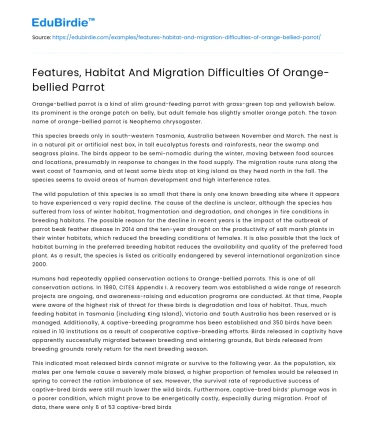Orange-bellied parrot is a kind of slim ground-feeding parrot with grass-green top and yellowish below. Its prominent is the orange patch on belly, but adult female has slightly smaller orange patch. The taxon name of orange-bellied parrot is Neophema chrysogaster.
This species breeds only in south-western Tasmania, Australia between November and March. The nest is in a natural pit or artificial nest box, in tall eucalyptus forests and rainforests, near the swamp and seagrass plains. The birds appear to be semi-nomadic during the winter, moving between food sources and locations, presumably in response to changes in the food supply. The migration route runs along the west coast of Tasmania, and at least some birds stop at king island as they head north in the fall. The species seems to avoid areas of human development and high interference rates.
Save your time!
We can take care of your essay
- Proper editing and formatting
- Free revision, title page, and bibliography
- Flexible prices and money-back guarantee
The wild population of this species is so small that there is only one known breeding site where it appears to have experienced a very rapid decline. The cause of the decline is unclear, although the species has suffered from loss of winter habitat, fragmentation and degradation, and changes in fire conditions in breeding habitats. The possible reason for the decline in recent years is the impact of the outbreak of parrot beak feather disease in 2014 and the ten-year drought on the productivity of salt marsh plants in their winter habitats, which reduced the breeding conditions of females. It is also possible that the lack of habitat burning in the preferred breeding habitat reduces the availability and quality of the preferred food plant. As a result, the species is listed as critically endangered by several international organization since 2000.
Humans had repeatedly applied conservation actions to Orange-bellied parrots. This is one of all conservation actions. In 1980, CITES Appendix I. A recovery team was established a wide range of research projects are ongoing, and awareness-raising and education programs are conducted. At that time, People were aware of the highest risk of threat for these birds is degradation and loss of habitat. Thus, much feeding habitat in Tasmania (including King Island), Victoria and South Australia has been reserved or is managed. Additionally, A captive-breeding programme has been established and 350 birds have been raised in 10 institutions as a result of cooperative captive-breeding efforts. Birds released in captivity have apparently successfully migrated between breeding and wintering grounds, But birds released from breeding grounds rarely return for the next breeding season.
This indicated most released birds cannot migrate or survive to the following year. As the population, six males per one female cause a severely male biased, a higher proportion of females would be released in spring to correct the ration imbalance of sex. However, the survival rate of reproductive success of captive-bred birds were still much lower the wild birds. Furthermore, captive-bred birds’ plumage was in a poorer condition, which might prove to be energetically costly, especially during migration. Proof of data, there were only 6 of 53 captive-bred birds survived to return after migration. The behavior of released birds has been monitored and differs in many respects for those of wild parrots. More investigations is still in progress.






 Stuck on your essay?
Stuck on your essay?

